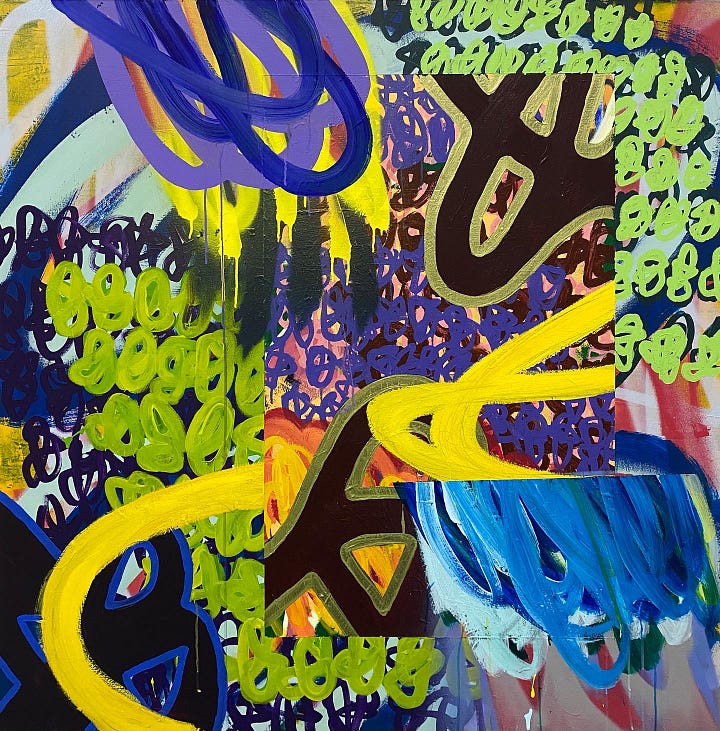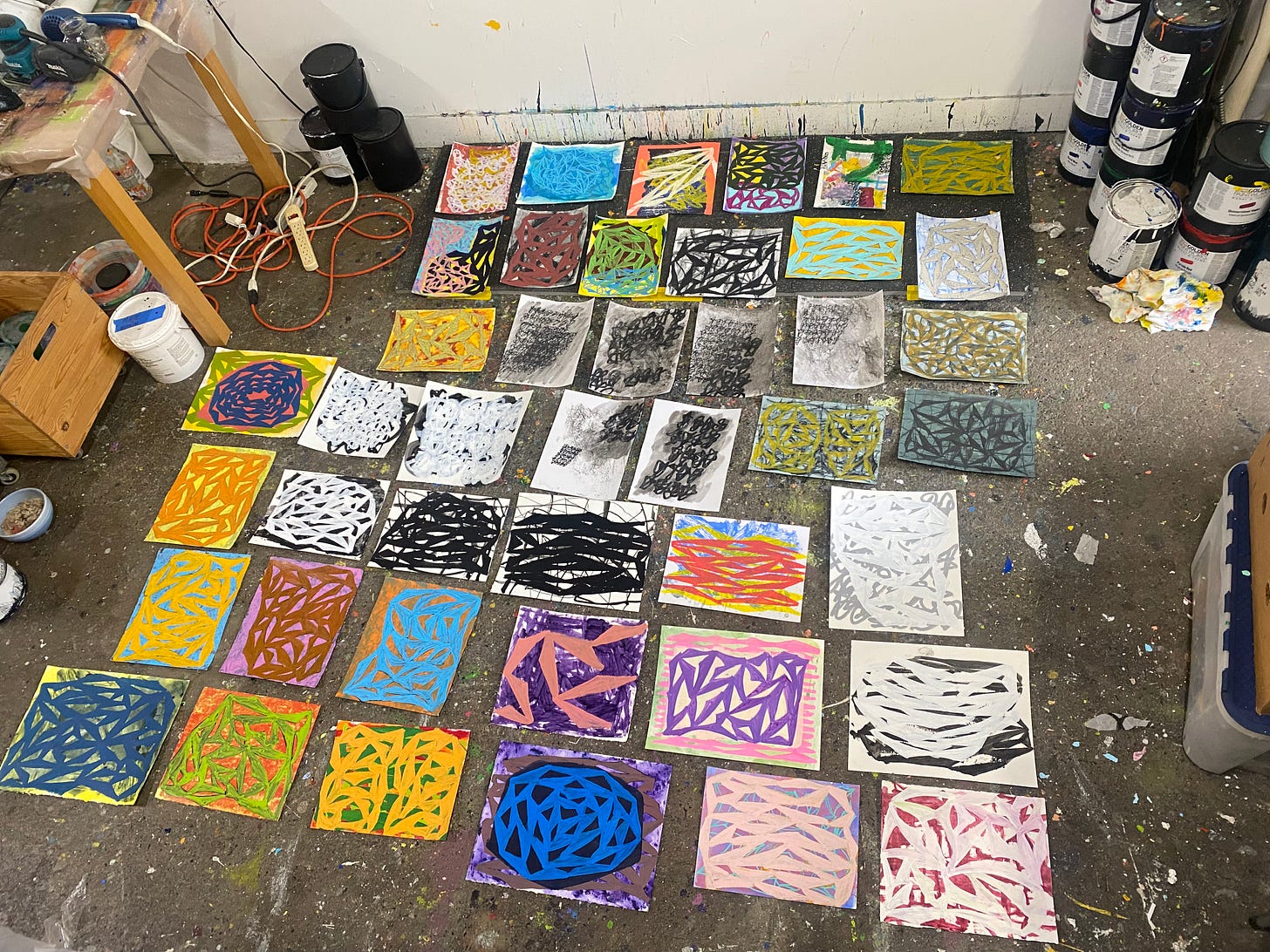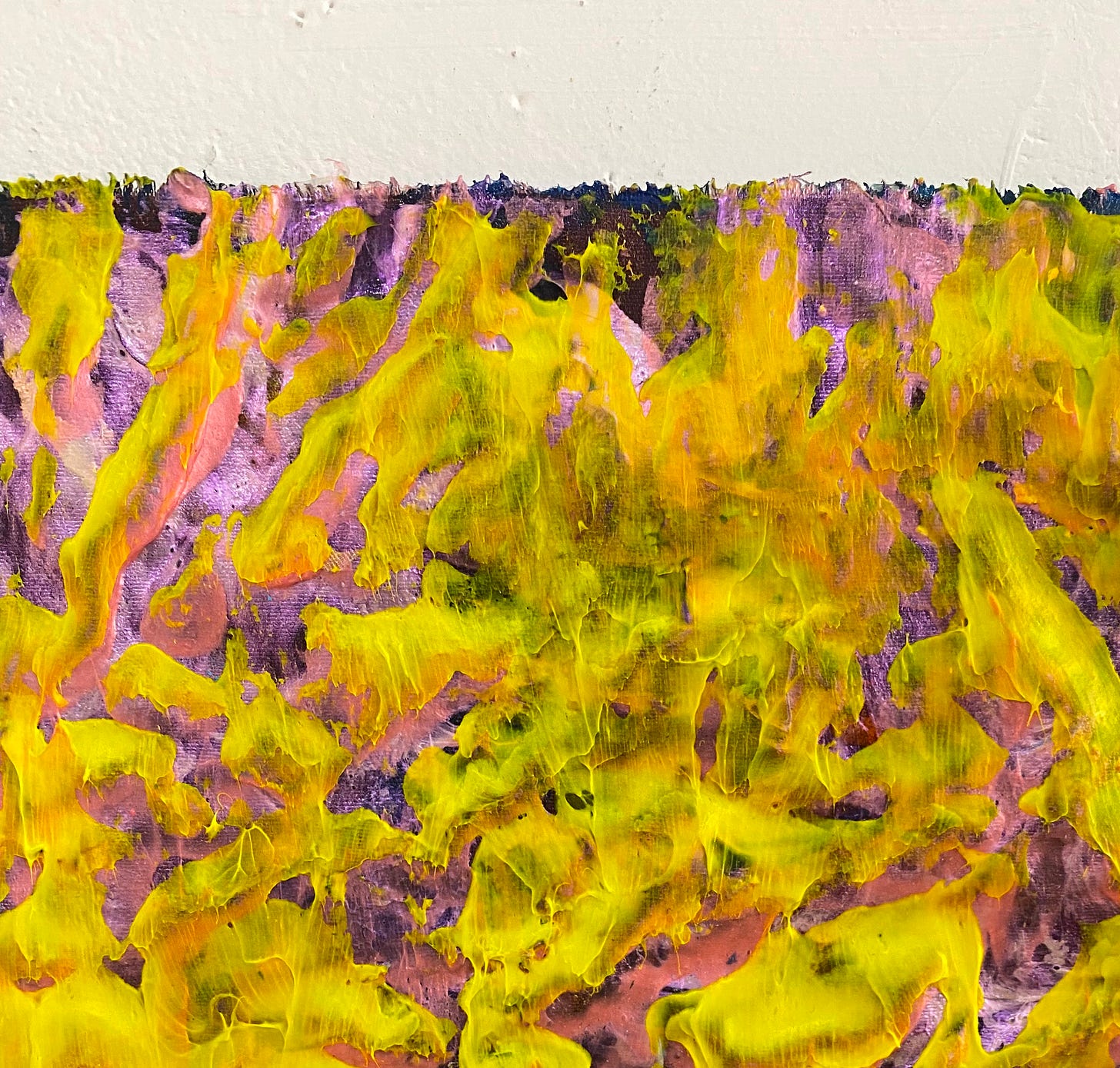I had a moment recently where on two of my work tables, there were a couple of piles of smallish works on paper that I’d made between late ‘24 and into this year. I think I was looking for something else a couple of weeks ago and had to move one of the piles. In doing so, I had to flip through the pieces to see what was there, because that’s what you do; make a bunch of stuff, pile it up and look through it periodically, astonished, even, when you find things that you completely forgot about. “Wait, when did I make this?!” (This happens more often than you might think, haha!)
This is completely normal for me. I make a lot of drawings and mixed media pieces on paper mostly just to get some idea or another out of my head fast. Some aspects of my works on paper may make it into paintings, but only some. Most of the time, I see these as full pieces on their own and not merely another step in the painting process.
Anyway, one day last week, I got into a mood where I wanted to got through the piles of paper works and lay them out to look at with a little distance. When I have a large number of pieces like this, I like either pinning them to the wall or laying them out on the floor to get a better look. I liken going through the piles in my hand the same way I view phone scrolling. You get a quick snapshot of something, but not much of an understanding of the work as when you can take your time to engage with it.
I consider some of these finished, some feel like they could use a little more added and others may wind up being a part of something else as collage elements.
Sometimes, I make these and will sign and date them shortly after making and at other times, I’ll just be iterating and forget about ‘em. I’ll make a bunch, put them somewhere and forget about them until I have to move something else months later. Unless I have a very specific series name, most of these will get the date of completion as a title. I make so many works on paper that giving them all specific titles seem fruitless. Making a date the title helps in categorizing them, mainly in identifying what year they were made.
I’m glad I took the time to at least lay these drawings** out like this. It gave me a chance to make some assessments, see connections, strengths and weaknesses and which ones (or parts of them) could possibly be scaled up to paintings. I’m still not sure about that last one, yet, but we’ll see.
[**Even though I’m using paint for many of my works on paper, I still consider them “drawings” mainly because paper is the support and how I’m using the mediums. I could call some of them paintings on paper, but they really aren’t, to me. Scale plays a part in this, also.]
“The ArtShow” this Friday!


This Friday, “The ArtShow” opens at the Hicks Art Center Gallery, in Newtown, PA and my painting, One Way Out (above) is included. This group exhibition is the first physical exhibition of artists who have appeared on ArtShow With Craig Stover at The Hicks Art Center Gallery that opens to the public on Friday, May 16 at 5pm.
ArtShow is a 1/2 hour artist interview program, hosted by Craig Stover. It showcases a wide variety of artists from many different artistic disciplines and gives viewers a chance to listen to the artists talk about a selection of their works as well as their history, process, techniques and interests.
Here’s my interview on ArtShow with more information about the exhibition just below the video:
Exhibition Dates: May 16 - July 19, 2025
Opening Reception: Friday, May 16, 2025 5-8pm
Closing Reception: Thursday, July 17, 2025 5-8pm
Address: 275 Swamp Rd, Newtown, PA 18940
Gallery Hours: Monday - Friday 10am - 6pm, Saturday 12 - 4pm
Free and open to the public
Participating Artists:
Francis Beaty, Henry Bermudez, Jill Bonovitz, Thomas Brady, Leora Brecher, Arden Bendler Browning, Diane Burko, Jerome China, Won Choi, Matthew Colaizzo, Gerald Cyrus, Ward Davenny, Steven Donegan, Jon Eckel, Mikel Elam, Paul Timothy Gierschick II, Melissa M. Haims, Lisa Haun, Darla Jackson, Jon Manteau, Tim McFarlane, Jedediah Morfit, Stuart Netsky, Stuart Rome, Rachel Romano, Rebecca Rutstein, Samantha Simpson, Larry Spaid, Simone Spicer, Gerri Spilka, Robert Straight, Kate Stewart, Craig Stover, Ron Tarver, Robin Tedesco, Amanda Tinker & Ben Weaver
Learn about all these artists and many more by watching and subscribing (free!) to www.youtube.com/@ArtShowwithCraigStover
“Thank you all who came to my opening last night and for not asking me what it all means, but being interested in how it made you feel. Love ya’ll
The above is a slightly paraphrased quote from an IG post I came across recently. The artist who wrote it had just had an opening reception and this was her caption for the images she posted.
I immediately a visceral, but very positive reaction when I read it. This was it! The artist’s words just gets to the heart of one of the things about creativity and putting your work out into the world. I don’t need everyone to “understand” it at first, or at all, for that matter.
What did it make you feel?! That’s the conversation we need to have about art and how people engage with it.
Understanding the meaning(s) of something comes from a slightly different place than the emotional impact. There’s overlap there, because having background information about the external influences on a piece of art is important. Often, the more information we have about certain artworks will deepen our connections with the work. Encountering artwork for the first time without that information means that we’re often relying on what we see and feel in the moment to guide our feelings about it. This can turn into an internal excavation of sorts…
Did it remind you of something or someplace?
Did the shapes, forms and/or colors affect you in some way?
How did you feel walking towards/from it?
Was there a visceral reaction to something about the piece?
Did you have a more contemplative reaction?
What do you think provoked any of your feelings and reactions?
So, if you think about any of the above questions when first encountering art, there’s already a heap of information that you might be coming away with prior to getting more academic information about the work and/or artist.
I’m more interested in viewers having an emotional connection or reaction of any kind, positive or negative, than if they “get” the work at first. Understanding art from the historical, social, political contexts and is important, but before all of that, art engages with our most inner selves and can trigger any number of reactions. I’ll only speak for myself, but as I wrote above, the most important aspect of people engaging with work is emotional.
The world around us continually tries to push us away from our inner selves. We grow up and are forced to disavow our most free, emotionally connected selves in service of other people’s needs and agendas. Then, at some point, we have to try and reconnect to those parts of ourselves we put away to fit in, whatever that means.
Art is a live wire that touches on our most primal instincts: self expression, autonomy, self determination and most importantly, our notions of freedom as human beings. It’s vitally important for everyone to understand that meaning comes from within. You finish the work, regardless of its status as a finished work of art put forth by the artist, gallery or institution. You are free to feel whatever you feel about the art. No one else can take that away.
The work may have emerged from a specific idea that the artist had, but the meaning changes when you encounter it and project your life and experiences onto it. We all project ourselves onto any artwork, book, dance, music, etc… and that’s completely legitimate. It’s all ok, as long as the work makes you feel something. Sometimes, it can take a while to understand and process those feelings but at the very least, it’s important that you feel something.
Question: When you’re encountering artwork for the first time, contemporary or otherwise, whether you already know the artist’s work or not, are you comfortable with just looking at and engaging with it for a while without having a press release or do you need to know more about the work first?
No wrong answers. I’m just curious, so feel free to leave a comment or message.
Thanks for reading and I’ll catch up again, soon!
TM




When I am looking at artwork of any kind, I do like to look at it from a distance first, before interacting with any sort of explanation that may be displayed next to it. I do like information, but I also feel like it's more meaningful (and maybe respectful?) to regard something first, before jumping in and reading the answer key, so to speak.
The emotional connection and feeling is one of the reasons why I almost prefer to see works in a gallery setting vs a museum with explanatory wall text. It gives you time to make your own assessment vs the curatorial reading or artist statement.